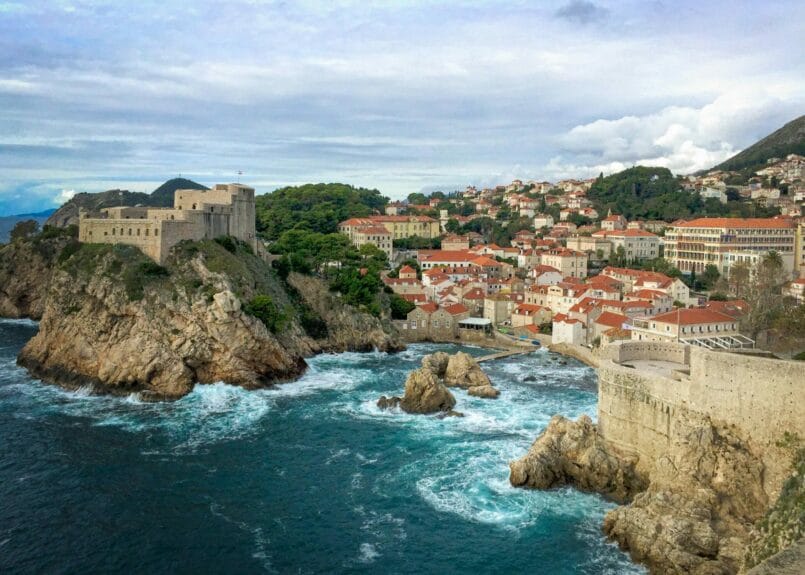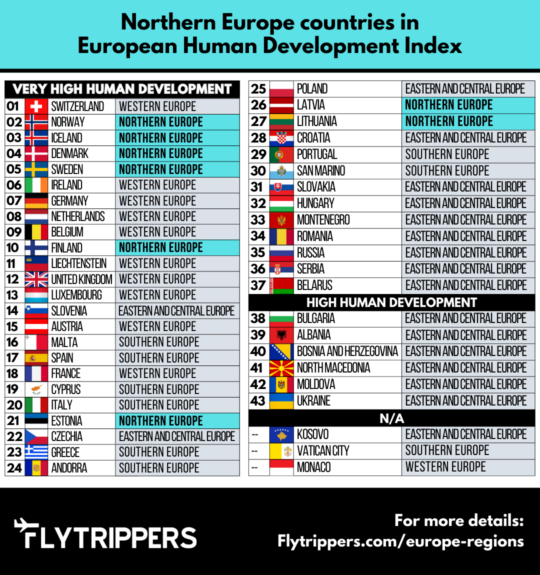Among all continents, Europe is by far the most visited continent by Canadians. That’s unsurprising, for historical reasons — Europe has long dominated the world. What is surprising is how so many people always visit the same countries in Europe. With 46 countries, the continent has so much variety (even if its land area is barely more than Canada).
One region of Europe, in particular, is much less crowded and more affordable than the others, and it’s by far our favorite.
Here’s our overview of the 4 different regions of Europe. And if you would love to see the same for other continents, we’ve already covered the 6 different regions of Asia and the 5 different regions of Africa.
Basics of the regions within continents
Generally speaking, the regions within a continent are more than just geographical: they are groupings of countries that, at least up to a point, share similar history, culture, and even nature sometimes.
Often, the regions are very different from one another despite being on the same continent. Western Asia is as different from Eastern Asia as it is from Europe. For example, some regions are much more developed than others.
That’s why, ideally, we strongly recommend you try to experience each region of each continent at least once, in the absence of the desire to visit every country in the world (not everyone is as passionate about travel as we are, and that’s okay).
Because how are you supposed to know what you prefer if you don’t try a bit of variety? And no, Portugal and Spain… that’s not really variety. We love it when we get you to explore more!
What are the 4 different regions of Europe?
Let’s take a look at the definition Flytrippers will use for all our many upcoming content pieces and other existing definitions.
Flytrippers’ definition of the 4 different regions of Europe
Here are the regions, counterclockwise, starting from the most popular:
- Western Europe (11 countries)
- Southern Europe (9 countries)
- Eastern/Central Europe (18 countries)
- Northern Europe (8 countries)

I give you a great overview of each region below, including how developed each country is, to give you a point of comparison of what to expect in terms of experience and prices.
We use the European Union definitions, but there is no universal definition of the different regions of Europe. It’s a continent where the precise boundaries of the regions are less well-defined. There is still much debate and disagreement on this subject, even more so than on other continents.
Never tell someone from Czechia that he’s Eastern European, as “Eastern” sadly has a negative connotation for many. That’s why Flytrippers prefers this 4-region model, even if it gives a vast Eastern and Central Europe region with much more variance.
Our only modifications were to move Andorra into Southern Europe (that makes so much more sense) and to exclude Türkiye and the Caucasus (Georgia, Armenia, Azerbaijan). These latter, considered part of either Asia or Europe depending on the source, will be included in the Western Asia region.
Other definitions of the different regions of Europe
The EU’s (European Union) definitions are obviously a little subjective. The UN (United Nations), for example, has very different definitions.
If you’re interested in better understanding the regions of Europe, here are the main variations that you could find:
- Eastern and Central Europe can be separated
- The borders are then very debated
- The Balkans can be considered in Southern Europe
- Those borders split up some very similar countries
- A Southeastern Europe region can exist
- It includes the Balkans, Greece, and Cyprus
- Western Europe and Northern Europe have few variations
- The British Isles can be included in Northern Europe
- The German-speaking countries can be in Central Europe
- The Western part of Southern Europe can be included in Western Europe
- That includes Spain, Portugal, and Italy
Overview of Europe’s 4 different regions
Here’s an overview of the 46 countries in each of these 4 different regions of Europe.
Western Europe (11 countries)
The 11 countries are almost all contiguous and can be divided into 4 subregions: the British Isles (2), France and Monaco (2), the Benelux (3), and the German-speaking countries (4).

11 countries in Western Europe:
- United Kingdom 🇬🇧
- Ireland 🇮🇪
- France 🇫🇷
- Monaco 🇲🇨
- Belgium 🇧🇪
- Netherlands 🇳🇱
- Luxembourg 🇱🇺
- Germany 🇩🇪
- Switzerland 🇨🇭
- Liechtenstein 🇱🇮
- Austria 🇦🇹

Western Europe comparisons
Population of Western Europe:
- 195 million (#2 out of 4)
- 5X more than Canada
Total area of Western Europe:
- 3.5 million km2 (#2 out of 4)
- 35% of Canada’s size
Here’s where the countries of Western Europe rank according to the Human Development Index (HDI). There’s no perfect measure for a country’s development as there are so many variables, but the Human Development Index (HDI) is the least imperfect one.

This region’s 11 countries are all extremely developed. All Western Europe countries are in the Europe HDI top 15, except France (18th) and Monaco (unranked).

Traveling in Western Europe
These countries are the most influential, and so they’re among the most popular destinations. Often, people choose countries because they heard more about them and they seem more accessible and simpler to travel to than lesser-known (but equally beautiful and interesting) countries.
Of course, it’s extremely expensive to travel to Western Europe. There’s obviously a strong correlation between how developed and how expensive places are. Apart from Southern France, the climate is also not that great for much of the year (for what most travelers prefer).

Some of the most beautiful places in the world are in this region, as history has been preserved very well in most areas. The mountains and countryside are very nice as well, and at least have fewer tourists than the overcrowded big cities.
Don’t miss our more detailed post about Western Europe soon.
Southern Europe (9 countries)
The 9 countries are all sort of connected by the Mediterrenean Sea and can be divided into 4 subregions that aren’t contiguous over land: the Iberian peninsula (3), Italy and its enclaved microstates (3), the islands (2), and Greece.

9 countries in Southern Europe:
- Portugal 🇵🇹
- Spain 🇪🇸
- Andorra 🇦🇩
- Italy 🇮🇹
- San Marino 🇸🇲
- Vatican 🇻🇦
- Malta 🇲🇹
- Cyprus 🇨🇾
- Greece 🇬🇷

Southern Europe comparisons
Population of Southern Europe:
- 153 million (#3 out of 4)
- 4X more than Canada
Total area of Southern Europe:
- 2.3 million km2 (#4 out of 4)
- 23% of Canada’s size
Here’s where the countries of Southern Europe rank according to the Human Development Index.

The countries are also very highly developed, but less so than Western Europe (only Malta and Spain are above France). All Southern Europe countries rank from 16th to 24th in HDI, apart from Portugal and San Marino at 29th and 30th (the Vatican is unranked).

Traveling in Southern Europe
This is another extremely popular region, with a bunch of other extremely influential countries but with the added benefit of at least having the continent’s best climate for those who want to be able to explore comfortably during the shoulder seasons or to enjoy very warm weather in the summer.
It’s another extremely expensive region to travel to. Even though Portugal can indeed be a bit better than neighboring countries, it’s still only “affordable” in comparison with literally one of the worst regions in the world in terms of costs.

Despite the expensive prices, some of the prettiest places in the world are in this region, especially if you like coastal areas. But even the inland parts are amazing. Many of the world’s greatest civilizations were within these borders.
Don’t miss our more detailed post about Southern Europe soon.
Eastern and Central Europe (18 countries)
The 18 countries cover a vast area of mainland Europe and can generally be divided into 6 subregions: the central countries bordering Western Europe (4), the Adriatic coastline (5), the rest of the former Yugoslavia (3), the rest of the Balkans (2), the former Soviet republics (3), and Russia.

18 countries in Eastern and Central Europe:
- Poland 🇵🇱
- Czechia 🇨🇿
- Slovakia 🇸🇰
- Hungary 🇭🇺
- Slovenia 🇸🇮
- Croatia 🇭🇷
- Bosnia and Herzegovina 🇧🇦
- Montenegro 🇲🇪
- Albania 🇦🇱
- Serbia 🇷🇸
- Kosovo 🇽🇰
- North Macedonia 🇲🇰
- Bulgaria 🇧🇬
- Romania 🇷🇴
- Moldova 🇲🇩
- Ukraine 🇺🇦
- Belarus 🇧🇾
- Russia 🇷🇺

Eastern and Central Europe comparisons
Population of Eastern and Central Europe:
- 387 million (#1 out of 4)
- 10X more than Canada
Total area of Eastern and Central Europe:
- 5.2million km2 (#1 out of 4)
- 52% of Canada’s size
*Excludes the Asian part of Russia
Here’s where the countries of Eastern and Central Europe rank according to the Human Development Index.

First, 11 of the 18 countries are in the same “very highly developed” category. Slovenia even surpasses France, while Czechia, Poland, and Croatia all surpass Portugal.
The other 6 fall into “highly developed” (and Kosovo is unranked).

Traveling in Eastern and Central Europe
This region has very popular parts and others that are even better off-the-beaten-path. But while there’s a lot of variety between those 6 subregions, the entire region is highly developed and easy to travel around.
It is by far our favorite region of Europe. It’s the most affordable and the least touristy, so that’s quite a win-win situation! It’s so much cheaper than the rest of the continent, especially outside of the 4 central countries and the northern Adriatic coast.

There’s just as much history and cultural attractions, but with even more culture shock. The natural attractions are also stunning. It should definitely be on your list. Whatever aspects of the other regions of Europe you love, there’s undoubtedly an equivalent in this region.
Don’t miss our more detailed post about Eastern and Central Europe soon.
Northern Europe (8 countries)
These 8 countries are in 4 separate areas that don’t have land borders between each other: the Scandinavian peninsula and the rest of Finland (3), the Baltic countries (3), Iceland, and Denmark (including Greenland, although that is geographically in North America).

8 countries in Northern Europe:
- Norway 🇳🇴
- Sweden 🇸🇪
- Finland 🇫🇮
- Estonia 🇪🇪
- Latvia 🇱🇻
- Lithuania 🇱🇹
- Iceland 🇮🇸
- Denmark 🇩🇰

Northern Europe comparisons
Population of Northern Europe:
- 105 million (#4 out of 4)
- 3X more than Canada
Total area of Northern Europe:
- 2.4 million km2 (#3 out of 4)
- 24% of Canada’s size
Here’s where the countries of Northern Europe rank according to the Human Development Index.

Most of Northern Europe is actually even more developed than the other regions: 4 countries in Northern Europe are in the HDI top 5 (the 3 Scandinavian countries and Iceland) and Finland is not far behind (10th).
The Baltics are a bit lower (21-26-27), unsurprisingly due to their not-so-distant Soviet past, but that’s still higher than Portugal.

Traveling in Northern Europe
While it’s not quite as popular as Western and Southern Europe for Canadians, this region is still extremely popular.
You probably guessed it, but this is one of the most expensive places in the world to travel to. Everything is extremely pricey, at least outside the Baltics.

While these countries might not have the same worldwide influence due to their smaller population, there’s a lot to see. Some of these places are ranked among the best to live in, so logically, they’re fun to visit, too. And the nature in most of these countries is breathtaking.
Don’t miss our more detailed post about Northern Europe soon.
Learning how to travel for less
Join over 100,000 savvy Canadian travelers who already receive Flytrippers’ free newsletter so we can help you travel for less (and inspire you, too)!




